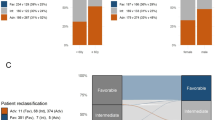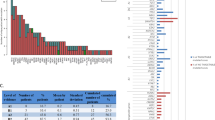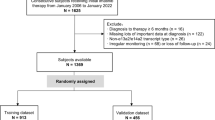Abstract
Therapeutic resistance remains the principal problem in acute myeloid leukemia (AML). We used area under receiver-operating characteristic curves (AUCs) to quantify our ability to predict therapeutic resistance in individual patients, where AUC=1.0 denotes perfect prediction and AUC=0.5 denotes a coin flip, using data from 4601 patients with newly diagnosed AML given induction therapy with 3+7 or more intense standard regimens in UK Medical Research Council/National Cancer Research Institute, Dutch–Belgian Cooperative Trial Group for Hematology/Oncology/Swiss Group for Clinical Cancer Research, US cooperative group SWOG and MD Anderson Cancer Center studies. Age, performance status, white blood cell count, secondary disease, cytogenetic risk and FLT3-ITD/NPM1 mutation status were each independently associated with failure to achieve complete remission despite no early death (‘primary refractoriness’). However, the AUC of a bootstrap-corrected multivariable model predicting this outcome was only 0.78, indicating only fair predictive ability. Removal of FLT3-ITD and NPM1 information only slightly decreased the AUC (0.76). Prediction of resistance, defined as primary refractoriness or short relapse-free survival, was even more difficult. Our limited ability to forecast resistance based on routinely available pretreatment covariates provides a rationale for continued randomization between standard and new therapies and supports further examination of genetic and posttreatment data to optimize resistance prediction in AML.
This is a preview of subscription content, access via your institution
Access options
Subscribe to this journal
Receive 12 print issues and online access
$259.00 per year
only $21.58 per issue
Buy this article
- Purchase on Springer Link
- Instant access to full article PDF
Prices may be subject to local taxes which are calculated during checkout

Similar content being viewed by others
References
Estey E, Döhner H . Acute myeloid leukaemia. Lancet 2006; 368: 1894–1907.
Döhner H, Estey EH, Amadori S, Appelbaum FR, Büchner T, Burnett AK et al. Diagnosis and management of acute myeloid leukemia in adults: recommendations from an international expert panel, on behalf of the European LeukemiaNet. Blood 2010; 115: 453–474.
Ferrara F, Schiffer CA . Acute myeloid leukaemia in adults. Lancet 2013; 381: 484–495.
Burnett AK, Russell NH, Hills RK, Hunter AE, Kjeldsen L, Yin J et al. Optimization of chemotherapy for younger patients with acute myeloid leukemia: results of the medical research council AML15 trial. J Clin Oncol 2013; 31: 3360–3368.
Kayser S, Zucknick M, Döhner K, Krauter J, Köhne CH, Horst HA et al. Monosomal karyotype in adult acute myeloid leukemia: prognostic impact and outcome after different treatment strategies. Blood 2012; 119: 551–558.
Harrell FE Jr . Regression Modeling Strategies: With Applications To Linear Models, Logistic Regression, And Survival Analysis. Springer: New York, NY, USA, 2001.
Pepe MS . The Statistical Evaluation Of Medical Tests For Classification And Prediction. Oxford University Press: New York, NY, USA, 2004.
Swerdlow SH, Campo E, Harris NL, Jaffe ES, Pileri SA, Stein H et al WHO Classification of Tumours of Haematopoietic and Lymphoid Tissue, 4th edn. IARC: Lyon, France, 2008.
Walter RB, Othus M, Borthakur G, Ravandi F, Cortes JE, Pierce SA et al. Prediction of early death after induction therapy for newly diagnosed acute myeloid leukemia with pretreatment risk scores: a novel paradigm for treatment assignment. J Clin Oncol 2011; 29: 4417–4423.
Cheson BD, Bennett JM, Kopecky KJ, Buchner T, Willman CL, Estey EH et al. Revised recommendations of the international working group for diagnosis, standardization of response criteria, treatment outcomes, and reporting standards for therapeutic trials in acute myeloid leukemia. J Clin Oncol 2003; 21: 4642–4649.
Kaplan EL, Meier P . Nonparametric estimation from incomplete observations. J Am Stat Assoc 1958; 53: 457–481.
Muller MP, Tomlinson G, Marrie TJ, Tang P, McGeer A, Low DE et al. Can routine laboratory tests discriminate between severe acute respiratory syndrome and other causes of community-acquired pneumonia? Clin Infect Dis 2005; 40: 1079–1086.
Ishihara R, Yamada T, Iishi H, Kato M, Yamamoto S, Yamamoto S et al. Quantitative analysis of the color change after iodine staining for diagnosing esophageal high-grade intraepithelial neoplasia and invasive cancer. Gastrointest Endosc 2009; 69: 213–218.
Roelen CA, van Rhenen W, Groothoff JW, van der Klink JJ, Bultmann U, Heymans MW . The development and validation of two prediction models to identify employees at risk of high sickness absence. Eur J Public Health 2013; 23: 128–133.
Harrell FE Jr, Lee KL, Mark DB . Multivariable prognostic models: issues in developing models, evaluating assumptions and adequacy, and measuring and reducing errors. Stat Med 1996; 15: 361–387.
Harrell FE Jr, Margolis PA, Gove S, Mason KE, Mulholland EK, Lehmann D et al. Development of a clinical prediction model for an ordinal outcome: the World Health Organization Multicentre Study of Clinical Signs and Etiological agents of Pneumonia, Sepsis and Meningitis in Young Infants. WHO/ARI Young Infant Multicentre Study Group. Stat Med 1998; 17: 909–944.
Othus M, Appelbaum FR, Petersdorf S, Erba HP, Estey EH . Evaluation of which patients get a second course of 3+7 on cooperative group trials for newly diagnosed acute myeloid leukemia: a report from SWOG [abstract]. Blood 2013; 122: 3925.
Appelbaum FR, Gundacker H, Head DR, Slovak ML, Willman CL, Godwin JE et al. Age and acute myeloid leukemia. Blood 2006; 107: 3481–3485.
Yanada M, Garcia-Manero G, Borthakur G, Ravandi F, Kantarjian H, Estey E . Relapse and death during first remission in acute myeloid leukemia. Haematologica 2008; 93: 633–634.
Krug U, Röllig C, Koschmieder A, Heinecke A, Sauerland MC, Schaich M et al. Complete remission and early death after intensive chemotherapy in patients aged 60 years or older with acute myeloid leukaemia: a web-based application for prediction of outcomes. Lancet 2010; 376: 2000–2008.
Taskesen E, Bullinger L, Corbacioglu A, Sanders MA, Erpelinck CA, Wouters BJ et al. Prognostic impact, concurrent genetic mutations, and gene expression features of AML with CEBPA mutations in a cohort of 1182 cytogenetically normal AML patients: further evidence for CEBPA double mutant AML as a distinctive disease entity. Blood 2011; 117: 2469–2475.
Ley TJ, Ding L, Walter MJ, McLellan MD, Lamprecht T, Larson DE et al. DNMT3A mutations in acute myeloid leukemia. N Engl J Med 2010; 363: 2424–2433.
Paschka P, Schlenk RF, Gaidzik VI, Habdank M, Kronke J, Bullinger L et al. IDH1 and IDH2 mutations are frequent genetic alterations in acute myeloid leukemia and confer adverse prognosis in cytogenetically normal acute myeloid leukemia with NPM1 mutation without FLT3 internal tandem duplication. J Clin Oncol 2010; 28: 3636–3643.
Metzeler KH, Becker H, Maharry K, Radmacher MD, Kohlschmidt J, Mrozek K et al. ASXL1 mutations identify a high-risk subgroup of older patients with primary cytogenetically normal AML within the ELN Favorable genetic category. Blood 2011; 118: 6920–6929.
Rücker FG, Schlenk RF, Bullinger L, Kayser S, Teleanu V, Kett H et al. TP53 alterations in acute myeloid leukemia with complex karyotype correlate with specific copy number alterations, monosomal karyotype, and dismal outcome. Blood 2012; 119: 2114–2121.
Patel JP, Gonen M, Figueroa ME, Fernandez H, Sun Z, Racevskis J et al. Prognostic relevance of integrated genetic profiling in acute myeloid leukemia. N Engl J Med 2012; 366: 1079–1089.
Walter MJ, Shen D, Ding L, Shao J, Koboldt DC, Chen K et al. Clonal architecture of secondary acute myeloid leukemia. N Engl J Med 2012; 366: 1090–1098.
Haferlach T, Kern W, Schoch C, Schnittger S, Sauerland MC, Heinecke A et al. A new prognostic score for patients with acute myeloid leukemia based on cytogenetics and early blast clearance in trials of the German AML Cooperative Group. Haematologica 2004; 89: 408–418.
Elliott MA, Litzow MR, Letendre LL, Wolf RC, Hanson CA, Tefferi A et al. Early peripheral blood blast clearance during induction chemotherapy for acute myeloid leukemia predicts superior relapse-free survival. Blood 2007; 110: 4172–4174.
Loken MR, Alonzo TA, Pardo L, Gerbing RB, Raimondi SC, Hirsch BA et al. Residual disease detected by multidimensional flow cytometry signifies high relapse risk in patients with de novo acute myeloid leukemia: a report from Children's Oncology Group. Blood 2012; 120: 1581–1588.
Lacombe F, Arnoulet C, Maynadié M, Lippert E, Luquet I, Pigneux A et al. Early clearance of peripheral blasts measured by flow cytometry during the first week of AML induction therapy as a new independent prognostic factor: a GOELAMS study. Leukemia 2009; 23: 350–357.
Freeman SD, Virgo P, Couzens S, Grimwade D, Russell N, Hills RK et al. Prognostic relevance of treatment response measured by flow cytometric residual disease detection in older patients with acute myeloid leukemia. J Clin Oncol 2013; 31: 4123–4131.
Terwijn M, van Putten WL, Kelder A, van der Velden VH, Brooimans RA, Pabst T et al. High Prognostic Impact of Flow Cytometric Minimal Residual Disease Detection in Acute Myeloid Leukemia: Data From the HOVON/SAKK AML 42A Study. J Clin Oncol 2013; 31: 3889–3897.
Grimwade D, Hills RK, Moorman AV, Walker H, Chatters S, Goldstone AH et al. Refinement of cytogenetic classification in acute myeloid leukemia: determination of prognostic significance of rare recurring chromosomal abnormalities among 5876 younger adult patients treated in the United Kingdom Medical Research Council trials. Blood 2010; 116: 354–365.
Breems DA, Van Putten WL, De Greef GE, Van Zelderen-Bhola SL, Gerssen-Schoorl KB, Mellink CH et al. Monosomal karyotype in acute myeloid leukemia: a better indicator of poor prognosis than a complex karyotype. J Clin Oncol 2008; 26: 4791–4797.
Acknowledgements
Research reported in this publication was supported by grants from the National Cancer Institute/National Institutes of Health (NCI/NIH; R21-CA182010 to RBW and MO, and R01-CA090998-09 to MO). SWOG trials were supported in part by the following PHS Cooperative Agreement grant numbers awarded by the NCI/NIH: U10-CA032102, U10-CA038926 and U10-CA105409. RBW is a Leukemia & Lymphoma Society Scholar in Clinical Research.
Author information
Authors and Affiliations
Corresponding author
Ethics declarations
Competing interests
The authors declare no conflict of interest.
Additional information
Presented in part at the 55th Annual Meeting of the American Society of Hematology, December 7–10, 2013, New Orleans, LA Version: July 23, 2014.
Supplementary Information accompanies this paper on the Leukemia website
Supplementary information
Rights and permissions
About this article
Cite this article
Walter, R., Othus, M., Burnett, A. et al. Resistance prediction in AML: analysis of 4601 patients from MRC/NCRI, HOVON/SAKK, SWOG and MD Anderson Cancer Center. Leukemia 29, 312–320 (2015). https://doi.org/10.1038/leu.2014.242
Received:
Revised:
Accepted:
Published:
Issue Date:
DOI: https://doi.org/10.1038/leu.2014.242
This article is cited by
-
Decitabine combined with low-dose cytarabine, aclarubicin and rhG-CSF regimen may be a potential alternative for relapsed/refractory acute myeloid leukemia: A single-center study
memo - Magazine of European Medical Oncology (2023)
-
Outcome prediction by the 2022 European LeukemiaNet genetic-risk classification for adults with acute myeloid leukemia: an Alliance study
Leukemia (2023)
-
Feasibility and efficacy of salvage allogeneic stem cell transplantation in AML patients relapsing after autologous stem cell transplantation
Bone Marrow Transplantation (2022)
-
Budget Impact Analysis of Gemtuzumab Ozogamicin for the Treatment of CD33-Positive Acute Myeloid Leukemia
PharmacoEconomics (2021)
-
Autologous hematopoietic cell transplantation following high-dose cytarabine consolidation for core-binding factor-acute myeloid leukemia in first complete remission: a phase 2 prospective trial
International Journal of Hematology (2021)



